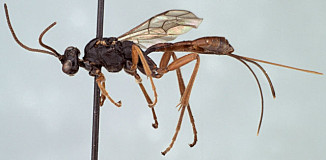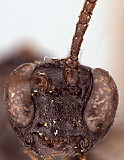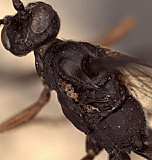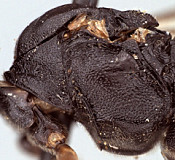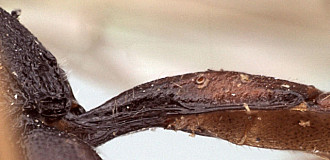Frons without median horn or elevated carina. Clypeus slightly extended ventral medially, thus relatively tall medially, strongly narrowing laterally; ventral margin thin, not bluntly rounded; epistomal sulcus shallow but distinct. Malar space very short, less than basal width of mandible. Mandible moderately broad, ventral tooth very slightly longer than dorsal tooth. Ocelli small, lateral ocellus much shorter than distance between ocellus and eye. Eyes deeply emarginate medially in female (Fig. 2), not as deeply emarginate in male, inner eye margins weakly converging ventrally in both sexes. Maxillary palp distinctly shorter than head height; female antenna distnctly shorter than body, most flagellomeres not longer than wide (Fig. 3); first flagellomere without tyloid. Hypostomal carina joining occipital carina well above base of mandible; occipital carina complete. Dorsal end of epicnemial carina extending to anterior margin of mesopleuron (Fig. 5). Notaulus broad, shallow, converging. Deep, u-shaped notch present between anterior end of lateral longitudinal carina of propodeum and adjacent part of metanotum in lateral view; pleural carina complete, well-developed; propodeal carinae poorly developed, nearly absent, with traces of lateral and median longitudinal carinae basally and of median longitudinal carina apically, transverse carinae absent. Apical margin of mid tibia expanded to form a small tooth similar to that on fore tibia; hind tibial spurs narrow throughout; all tarsal claws simple, never pectinate. Fore wing areolet absent in the two specimens examined (Fig. 6). Hind wing with first abscissa of CU1 distinctly longer than 1cu-a. T1 narrow, parallel-sided over basal half, abruptly widening posteriorly (more distinctly so in female than male); without basal depression at dorsal tendon attachment; a dorsal-lateral longitudinal carina present basally, weakly indicated from base to just dorsad spiracle, median dorsal carinae absent; glymmae absent. S1 extending not quite half length of T1 (Fig. 8), not extending to level of spiracle, which is slightly posteriorad midpoint. T2 lateral carina absent; T2 thyridium absent; laterotergite of T2 completely separated by crease; basal 0.3 of T3 laterotergite separated by crease, remainder rounded. Ovipositor straight, parallel-sided, long (Fig. 1), with exposed portion twice length of mesosoma; with narrow subapical notch near tip.
In his brief description of Olethrodotis, Townes (1970) states that the fore wing areolet is usually present, but in both of the specimens on which the above redescription is based, the areolet was absent.

